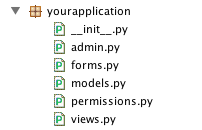Create a basic permission¶
Where to store permissions?¶
First of all: All following permission classes should be placed in a file
called permissions.py in your application. For the why please have a
look on How permissions are discovered.
Basic permissions¶
Let’s start with an example:
import authority
from authority import permissions
from django.contrib.flatpages.models import FlatPage
class FlatpagePermission(permissions.BasePermission):
label = 'flatpage_permission'
authority.register(FlatPage, FlatpagePermission)
Let’s have a look at the code above. First of, if you want to create a new permission you have to subclass it from the BasePermission class:
from authority import permissions
class FlatpagePermission(permissions.BasePermission):
# ...
Next, you need to name this permission using the label attribute:
class FlatpagePermission(permissions.BasePermission):
label = 'flatpage_permission'
And finally you need to register the permission with the pool of all other permissions:
authority.register(FlatPage, FlatpagePermission)
The syntax of this is simple:
authority.register(<model>, <permission_class>)
While this is not much code, you already wrapped Django’s basic permissions
(add_flatpage, change_flatpage, delete_flatpage) for the model FlatPage
and you are ready to use it within your templates or code:
Note
See Django’s basic permissions how Django creates this permissions for you.
Example permission checks¶
This section shows you how to check for Django’s basic permissions with django-authority.
In your python code¶
def my_view(request):
check = FlatPagePermission(request.user)
if check.change_flatpage():
print "Yay, you can change a flatpage!"
Using the view decorator¶
from authority.decorators import permission_required_or_403
@permission_required_or_403('flatpage_permission.change_flatpage')
def my_view(request):
# ...
See Check permissions using the decorator how the decorator works in detail.
In your templates¶
{% ifhasperm "flatpage_permission.change_flatpage" request.user %}
Yay, you can change a flatpage!
{% else %}
Nope, sorry. You aren't allowed to change a flatpage.
{% endifhasperm %}
See Check permissions in templates how the templatetag works in detail.
How permissions are discovered¶
On first runtime of your Django project authority.autodiscover() will
load all permissions.py files that are in your settings.INSTALLED_APPS
applications. See Configuration how to set up autodiscover.

We encourage you to place your permission classes in a file called
permissions.py inside your application directories. This will not only
keep your application files clean, but it will also load every permission
class at runtime when used with authority.autodiscover().
If you really want, you can place these permission-classes in other files
that are loaded at runtime. __init__.py or models.py are such files.
